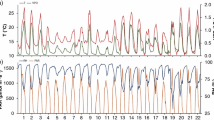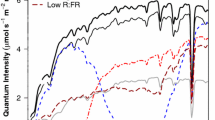Abstract
The role of energy reserves in development of winter hardiness was examined in timothy (Phleum pratense L.), orchardgrass (Dactylis glomerata L.) and perennial ryegrass (Lolium perenne L.) through periodically measuring etiolated growth (EG; shoot growth of crown under dark, warm and humid conditions following defoliation) and determining sugar profiles at critical stages of hardening and wintering. Seasonal changes in weight and duration of EG were monitored by sampling once or twice a month from September to the following April. In all species, total etiolated growth (TEG; total shoot production at each sampling time as determined by weekly or biweekly harvests until exhaustion of reserves) increased from September to reach peak levels during the second hardening stage in mid-November. Thereafter, TEG remained high until the following spring in orchardgrass while it declined linearly in timothy, which had the lowest TEG. The decline in TEG was intermediate in perennial ryegrass. Changes in the duration of EG were most marked in orchardgrass, as it required six weeks to produce about 150 mg g-1 TEG in early November but only one week in March. The results indicated occurrence of dormancy in apical meristems of orchardgrass at the end of the first hardening stage with temperatures above 0 °C, which roughly corresponded with the phase of dormancy in woody plants. Dormancy was weak in timothy and largely undetectable in perennial ryegrass, as measured by the EG technique. A positively significant correlation between total nonstructural carbohydrates (TNC) content and TEG was found in all species. Detailed analysis, however, showed that direct estimation of TNC content using TEG was difficult because TEG production per unit TNC was negatively correlated with TNC level, and the amount of TNC unused in early autumn was more than in the rest of the season. Changes in sugar profiles occurred at transition from the first to the second hardening stage with subzero temperatures and varied with wintering strategy of each species. Simple sugar content dramatically declined while fructan content increased in both timothy (cv. ‘Senpoku’) and orchardgrass (cv. ‘Wasemidori’), which were selected at sites covered with snow for more than 120 days. In contrast, a cold tolerant perennial ryegrass cv. `‘éveille’ selected in the Netherlands retained high amounts of simple sugars. The results suggest that EG technique is suitable to monitor physiological status (amount and rate of mobilization of energy reserves, intensity of dormancy and bud development) of plants expressing winter hardiness.
Similar content being viewed by others
References
Abe, J., 1980. Winter hardiness in Turkish populations of cocksfoot, Dactylis glomerata L. Euphytica 29: 531-538.
Albert, W.B., 1927. Studies on the growth of alfalfa and some perennial grasses. J Amer Soc Agron 19: 624-654.
Andrews, J.E., 1958. Controlled low temperature tests of sprouted seeds as a measure of cold hardiness of winter wheat varieties. Can J Plant Sci 38: 1-7.
Chatterton, N.J., P.A. Harrison, W.R. Thornley & J.H. Bennett, 1993. Structure of fructan oligomers in orchard grass (Dactylis glomerata L.). J Plant Physiol 142: 552-556.
Cunningham, S.M., J.J. Volenec & L.R. Teuber, 1998. Plant survival and root and bud composition of alfalfa populations selected for contrasting fall dormancy. Crop Sci 38: 962-969.
Davidson, J.L. & F.L. Milthorpe, 1966. Leaf growth in Dactylis glomerata following defoliation. Ann Bot 30: 173-184.
Davies, A., 1965. Carbohydrate levels and regrowth in perennial rye-grass. J Agric Sci 65: 213-221.
Dionne, J., Y. Castonguay, P. Nadeau & Y. Desjardins, 2001. Freezing tolerance and carbohydrate changes during cold acclimation of green-type annual bluegrass (Poa annua L.) ecotypes. Crop Sci 41: 443-451.
Graber, L.F., N.T. Nelson, W.A. Leukel & W.B. Albert, 1927. Organic food reserves in relation to the growth of alfalfa and other perennial herbaceous plants. Wisconsin Agr Exp Sta Res Bull 80.
Heide, O.M., 1985. Physiological aspects of climatic adaptation in plants with special reference to high-latitude environments. In: A. Kaurin, O. Junttila & J. Nilsen (Eds.), Plant Production in the North, pp. 1-22. Norwegian University Press, Tromsø.
Heide, O.M., 1994. Control of flowering and reproduction in temperate grasses. New Phytol 128: 347-362.
Hincha, D.K., E.M. Hellwege, A.G. Heyer & J.H. Crowe, 2000. Plant fructans stabilize phosphatidylcholine liposomes during freeze-drying. Eur J Biochem 267: 535-540.
Kiyomoto, R.K. & G.W. Bruehl, 1977. Carbohydrate accumulation and depletion by winter cereals differing in resistance to Typhula idahoensis. Phytopathology 67: 206-211.
Klebesadel, L.J., 1971. Selective modification of alfalfa toward acclimatization in a subarctic area of severe winter stress. Crop Sci 11: 609-614.
Klebesadel, L.J., 1985a. Hardening behavior, winter survival, and forage productivity of Festuca species and cultivars in subarctic Alaska. Crop Sci 25: 441-447.
Klebesadel, L.J., 1985b. Adaptational changes induced in temperate-adapted legumes by natural selection pressures in subarctic Alaska. In: A. Kaurin, O. Junttila & J. Nilsen (Eds.), Plant Production in the North, pp. 304-315. Norwegian University Press, Tromsø.
Klebesadel, L.J. & D. Helm, 1986. Food reserve storage, lowtemperature injury, winter survival, and forage yields of timothy in subarctic Alaska as related to latitude-of-origin. Crop Sci 26: 325-334.
Langer, R.H.M., 1956. Growth and nutrition of timothy (Phleum pratense). I. The life history of individual tillers. Ann appl Biol 44: 166-187.
Levitt, J., 1980. Responses of Plants to Environmental Stresses. 2nd edn., Vol. 1. Chilling, Freezing, and High Temperature Stresses. Academic Press, New York.
Livingston, D.P. III, 1996. The second phase of cold hardening: Freezing tolerance and fructan isomer changes in winter cereal crowns. Crop Sci 36: 1568-1573.
McKenzie, J.S., D.G. Stout & L.P. Lefkovitch, 1988. Alfalfa food reserves estimated chemically and by etiolated growth. Can J Plant Sci 68: 427-438.
Moriyama, M., J. Abe, M. Yoshida, Y. Tsurumi & S. Nakayama, 1995. Seasonal changes in freezing tolerance, moisture content and dry weight of three temperate grasses. Grassl Sci 41: 21-25.
Morvan-Bertrand, A., J. Boucaud & M.P. Prud'homme, 1999. Influence of initial levels of carbohydrates, fructans, nitrogen, and soluble proteins on regrowth of Lolium perenne L. cv. Bravo following defoliation. J Exp Bot 50: 1817-1826.
Nakajima, T. & J. Abe, 1994. Development of resistance to Microdochium nivale in winter wheat during autumn and decline of the resistance under snow. Can J Bot 72: 1211-1215.
Olien, C.R. & J.L. Clark, 1993. Changes in soluble carbohydrate composition of barley, wheat, and rye during winter. Agron J 85: 21-29.
Ozaki, M., 1979. Ecological study of Sclerotinia snow blight disease of orchradgrass. Bull Hokkaido Pref Agric Exp Stn 42: 55-65.
Pollock, C.J. & A.J. Cairns, 1991. Fructan metabolism in grasses and cereals. Annu Rev Plant Physiol Plant Mol Biol 42: 77-101.
Prud'homme, M.P., B. Gonzalez, J.P. Billard & J. Boucaud, 1992. Carbohydrate content, fructan and sucrose enzyme activities in roots, stubble and leaves of ryegrass (Lolium perenne L.) as affected by source / sink modification after cutting. J Plant Physiol 140: 282-291.
Rebichung, J., 1953. Étude sur la variabilité des populations naturelles française de dactyle. Ann Amélior Plantes 3: 311-349.
Rechel, E., 1993. Etiolated growth as a measure of non-structural biomass in lucerne taproots. Ann Bot 72: 103-106.
Richards, J.H., 1993. Physiology of plants recovering from defoliation. In: M.J. Baker (ed.), Grasslands for our world, pp. 46-54. SIR Publishing, Wellington, New Zealand.
Richards, J.H. & M.M. Caldwell, 1985. Soluble carbohydrates, concurrent photosynthesis and efficiency in regrowth following defoliation: A field study with Agropyron species. J Appl Ecol 22: 907-920.
Sakai, A. & W. Larcher, 1987. Frost Survival of Plants. Springer-Verlag, Berlin.
Schnyder, H. & R. de Visser, 1999. Fluxes of reserve-derived and currently assimilated carbon and nitrogen in perennial ryegrass recovering from defoliation. The regrowing tiller and its component functionally distinct zones. Plant Physiol 119: 1423-1435.
Stout, D.G., 1984. A comparison of etiolated growth and carbohydrate level as measures of alfalfa food reserves. Canada Agriculture 30: 32-35.
Sullivan, J.T. & V.G. Sprague, 1943. Composition of the roots and stubble of perennial ryegrass following partial defoliation. Plant Physiol 18: 656-670.
Tomiyama, K., 1955. Studies on the snow blight diseases of winter cereals. Hokkaido Natl Agric Exp Stn Rep 47: 1-234.
Vegis, A., 1964. Dormancy in higher plants. Ann Rev Plant Physiol 15: 185-224.
Vijn, I. & S. Smeekens, 1999. Fructan: More than a reserve carbohydrate? Plant Physiol 120: 351-359.
Volenec, J.J., A. Ourry & B.C. Joern, 1996. A role for nitrogen reserves in forage regrowth and stress tolerance. Physiol Plant 97: 185-193.
Yoshida, M., J. Abe, M. Moriyama & T. Kuwabara, 1998. Carbohydrate levels among winter wheat cultivars varying in freezing tolerance and snow mold resistance during autumn and winter. Physiol Plant 103: 8-16.
Author information
Authors and Affiliations
Rights and permissions
About this article
Cite this article
Moriyama, M., Abe, J. & Yoshida, M. Etiolated growth in relation to energy reserves and winter survival in three temperate grasses. Euphytica 129, 351–360 (2003). https://doi.org/10.1023/A:1022228216662
Issue Date:
DOI: https://doi.org/10.1023/A:1022228216662




